Design Festa
|
I had heard about Design
Festa for quite awhile
even before I moved over from the US. It's kind of like a US
Art Fair except that whereas the Art Fairs have all sorts of
entrance conditions and try to be selective, Design Festa
has no entrance conditions beyond willingness to pay $105
for a tiny 3'x6' booth (of course you can buy your way up
from there). As a result, there's a lot of random stuff
at Design Festa spread over about 2,600 booths.
The latest Design Festa was this past weekend (November 8-9),
at Tokyo Big Sight, a ginourmous convention center out in the
O-daiba area. Big Sight is also where the Tokyo Anime Fair
and Comiket are held.
Here's a list of the things I saw that caught my fancy or
attention -- I tried to cover the whole event although with
2,600 booths I'm sure I missed a few!
|
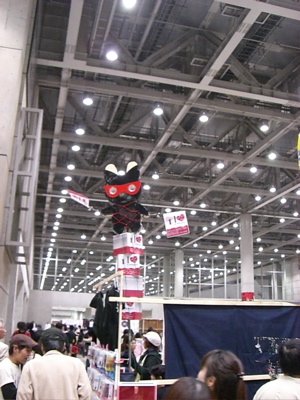
Above: Yes, it's bondage ninja kitty. Welcome to Design Festa.
Larger versions of most images are available on
my
Picasa album for Design Festa.
At left: I pose with some table-shaped friends.
|
|
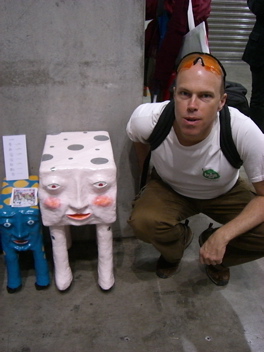
|
Onozawa Yukata - the World's Coolest Gesture Drawing

This guy's drawings are super-cool minimal gesture-drawing-like
drawings, many of them sexy drawings of women.
Although some of them also include some jet-blacks
areas, they mostly look like they're made with a simple marker.
He was very nice and soft-spoken, selling prints and postcards.
Here's his website.
It turns out Michael Chang and his friends were at Festa as well,
and they independently thought this guys' stuff was the most
notable thing at the show as well.
ランズエンド/Landsend
I've heard of Landsend (sic, that's how they write it in English)
magazine for quite some time. They started (or more accurately
popularized) the photographic movement of taking pictures of
ruined or abandoned places, which there are a lot of in Japan.
That trend is accelerating not only due to the reasons
found in any country (abandonment of old mining areas, migration
to the cities with the accompanying emptying out of the countryside),
but also because of Japan's overall population decline.
Landsend is an infrequent publication (2-3 times a year) that's
a glossy photography magainze for photographs of that subject matter.
Landsend doesn't particularly have a website, although Masaharu Takebe
has a website here.
One of the places that kicked off attention to this style of photography
was the spectacular pictures of an abandoned
military base in the Seto Inland Sea which was nicknamed
"battleship island" because it's a concrete
structure coming straight out of the water. There's a great online
gallery of pictures from Battleship Island
here.
I got to pick up a couple issues of Landsend, as well as meet the
staff. They energetically pronounced their magazine's subject matter
in English as "ruins", even though "abandoned buildings" is actually
a lot more accurate. It was great to be able to talk to them a bit,
their photographs are really compelling.
One of the issues I picked up is mostly photographs of a town with
a whole series of abandoned four-story concrete apartment buildings
on top of a hill overlooking a beautiful ocean view. He explained
this was a classic abandoned mining town: the local mine had worked
out the vein, and so these 60s-era apartments are slowly being
covered with ivy on this dramatic hilltop.
The other issue they were selling had some fantastic abandoned
factory buildings. Landsend definitely lives up to all the things
that are said about them in art press in the states!
Southeast Asian Fusion Dance Performance
New World Transparent Specimen
Japan is, of course, the country that has a museum for parasites
(the Meguro Parasitological Museum, conveniently located near
my house).
So it makes sense to see the New World Transparent Specimen
booth, which promoting their auctions (on Yahoo Auctions,
the major auction site here) of these brilliantly
colored biological specimens. They were really striking, I assume
the coloration is added on to these preserved fish, squids, shrimp
and so forth, although I don't really know. They are fascinating
though!
For some much better pictures, have a look at
their website or
their Yahoo! Auctions page.
|
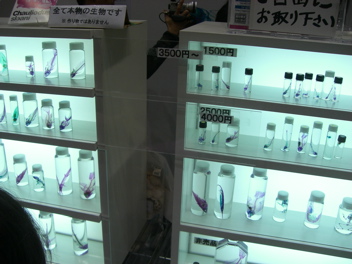
|
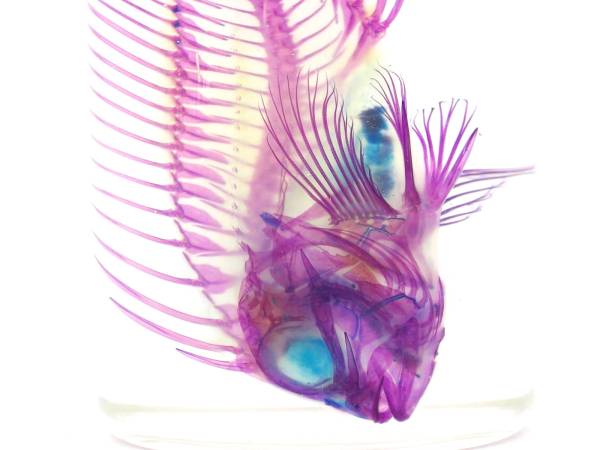
|
第N無人居住區/Larvahouse
A lot of my favorite things were upstairs right near the
dance stage. This was a huge, layered town-like structure all
built out of corrugated cardboard.
The nice lady who made it was there and we exchanged compliments.
Her tag line for larvahouse is 「だれもいなくなったまち」, meaning
roughly, "The town where everyone went away." Her website
is here.
|
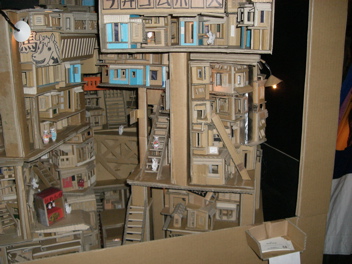
|
Izakaya, anyone?
However, that wasn't the coolest miniature thing at the show!
On the other side of the reduced-light area there were a series
of Vue D'Optique style flats, along with one extraordinarily
cool piece.
If you look at the left-hand picture below, it looks like a shot of
a very typical local Japanese eatery, maybe from a few years ago.
But in fact, it's a fastidiously built miniature. Look at the
right-hand picture and in the foreground you can see a clipboard
clip for scale; the tables are about 5cm tall.
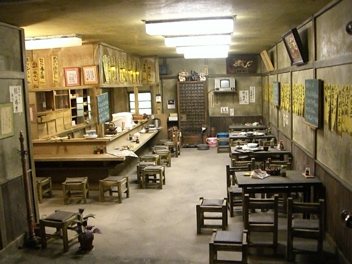
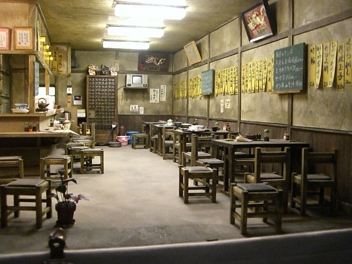
This piece absolutely mesmerized everyone who saw it with its
versimilitude, in particular children. I hate to wait quite a
while to take these photos just because everyone wanted to stare
in through the door! Unfortunately, I didn't get the artists'
name.
Papercraft
Besides miniatures, another theme running through Design Festa
was papercraft. There are a lot of fantastic artists fabricating
really cool stuff out of paper. I've blogged before about the
awesome Piperoidz, But a couple of the artists at Design Festa
have fused papercraft with a Hong Kong figure design sensibility
to get some awesome-looking characters!
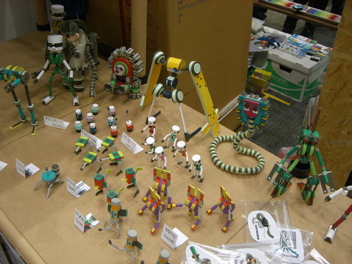
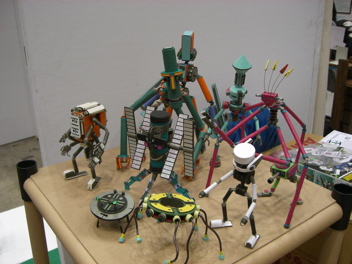
Above: こみ/Komi.
Below: まつもとやすたか/Yasutaka Matsumoto.
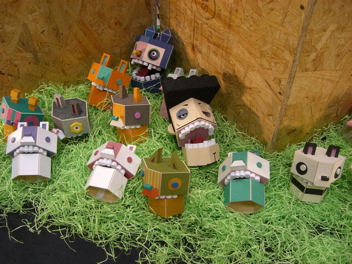
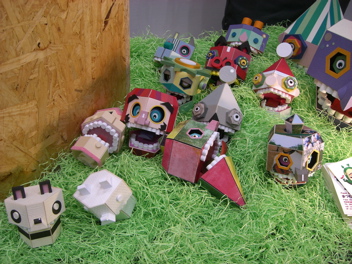
The last cool piece of papercraft was a company called
Handson that makes papercraft
kits to musical instruments like guitars, violins, cellos,
and so forth, including the strings.
They're really amazing, but the prototype for their next one
was even more incredible: a saxophone with all the levers!
Refugee from Ghibli?
|

|
One thing that can be a bit monotonous here is that character design
is so overwhelmingly influenced by anime/manga that characters with
that 'look' overwhelm all sorts of illustration and design.
Thankfully, Design Festa in general was an antidote to that, with
artistic influences from all over in clear evidence.
In particular, the artist
Asahi
with the slogan ポカポカ色, or
"mistaken colors", clearly comes not from the Tezuka/Manga tradition
but from the Toei/Miyazaki tradition. Their character really
seem like they could be studies for the next Ghibli film and the
colors are full and humanistic. The expressions are open-mouthed
wonder or full-belly laughs, a great counterpoint to the
typically emotionally reserved and overthought anime posing we
usually see here.
Escher in the Izakaya
One of the most intriguing traditional illustrators I saw was
寺坂安里/Anri Terazaka.
Her work all has a storybook style,
but in particular she produced a number of pieces that incorporated
an Escher-inspired distortion of perspective, made all the mode
striking because they were views into traditional Japanese
interiors. Since traditional interiors incorporate so many
rectilinear elements, the perspective warping became the focus
of the piece.
|

|
Steampunk Watches
Of the artists I talked to at Design Festa, none of them seemed
to be from Tokyo. Maybe it's just that living in Tokyo means being
too busy making money or something, but almost everybody seemed
to hail from elsewhere. It certainly was true of Ken Handmade
Watches, which was from Sendai Miyagi prefecture.
They make a whole line of hand-crafted watches (I'm sure
the mechanisms are manufactured elsewhere) that have a very
steampunk look. They're a bit expensive --
Y20,000 (U$200) and up -- but definitely having one means
you'll have a watch none of your friends have ever seen!
|
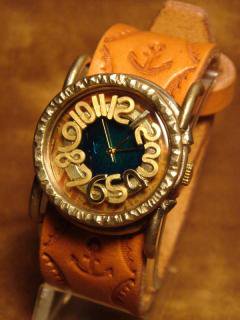
|
Hallym College
Although most of the artists and attendees were Japanese, there
was a good assortment of gaikokujin (foreigners) wandering the
aisles as well. In particular, there was one entire aisle of
students from Hallym Colelge in Korea. I was psyched because
they're from Chunchon, the small town in Korea I went to last
year. They were very surprised to meet a westerner who knew
where Chunchon was!
I wondered how Design Festa was for them, since most of them didn't
seem to particularly speak Japanese. I had initially started
talking to them in Japanese and we quickly realized it was much
better to communicate in English -- their Japanese was almost
non-existant.
Neotree -- Modular LED-based lighting
Unfortunately, my pictures of this didn't come out and they don't
really have any information on
their website (which is mostly in Korean anyway), but their idea
was to take high-intensity LED lighting strips made by the
Lumens company and fabricate
a simple branching-tree structure. The user could then buy as
many as they wanted and mount them in any sort of tree structure.
The bright LEDs are intended as indirect lighting, so you have a
backlit tree that floats about 4 cm off the wall due to standoff
posts.
The coolest thing about this is that you attach the power brick
only at the base of the tree; each module had plugs which
transmit the power throughout the tree. If I remember right,
each module was about Y4000 (U$40), so it isn't cheap lighting
just yet, but it was a cool idea.
B-side Label
There was an Osaka-based sticker/record company there called
B-side Label.
They had lots of great stickers, quite a numer of which are
on my notebook now. My favorite sticker of the show I didn't
pick up there, but rather around the corner. It has a primitive
drawing of a young boy holding a stuffed bear and saying,
"Daddy! Take us to FUN TOWN."
|

|
Fun Illustrators/Artists
Some other folks I saw:





